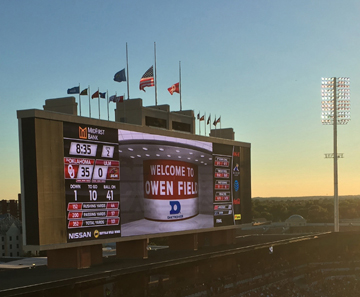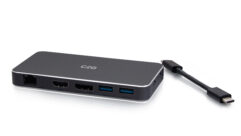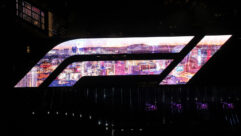
SVC Podcast – Show Notes – Show 163-1
In this edition of the SVC Podcast, SVC Contributing Editor Bennett Liles talks with Perry Grave of Daktronics about the new 47ft. by 167ft. LED video display board recently installed in the renovated Gaylord Family-Oklahoma Memorial Stadium at the University of Oklahoma. Perry discusses how the display project fitted with the larger stadium renovation project. He also details the video signal conveyance and temperature control for the giant new LED display board.
For Part 2
Links of interest:
- Daktronics, a leading manufacturer of outdoor LED video displays
- Daktronics YouTube Support Channel
- YouTube video showing the new board in its debut performance
Download Podcast Here:
https://s3.amazonaws.com/nb-svc/public/public/163-1_Daktronics_Oklahoma_…
This is the SVC Podcast from Sound & Video Contractor Magazine with Perry Grave of Daktronics. Show notes and equipment links for the podcast are on the web site of Sound & Video Contractor Magazine at svconline.com.
College football season is underway and at the University of Oklahoma the Sooners have a newly renovated stadium at Owen Field and a giant end zone display to show replays, commercial ads, scores and stats. Perry Grave is here from Daktronics to tell us about the huge new display and how it works. That’s coming right up on the SVC Podcast.
Perry, thanks for taking a timeout at Daktronics to be with us for the SVC Podcast. All I can say on looking at the pictures of this new University of Oklahoma end zone display is ‘wow’. If you had any bigger display there you would have to build a bigger stadium.
They definitely wanted to maximize the impact.
Yeah. I know this is a whole science in itself to get one of these installed and figure the maintenance and get people trained on operating it. But this whole project didn’t just spring up overnight. It took some time to get the ball rolling. At Daktronics you’re working way ahead on getting approvals and having all of the dominoes lined up for these display projects. So when did the University of Oklahoma start up on the plan for this?
Yeah, they started looking into doing this south end zone bowl-in as early as two or three years ago they started talking about it. And I think that’s when they brought in an architect and started drawing up some plans and designs. And then they started getting us involved in the project probably a year and a half to two years ago helping out with specifications, weights, attachment methods; because they were in the process of designing the structure and that just gave them a little advantage on how to do that. So it’s been ongoing for a long time now. [Timestamp: 1:56]
What kind of improvement did they want over what they had before, just a bigger display?
Yeah, I think bigger came into play at some point. They already had a pretty good-sized display there, but one of the things that they were lacking was the ability to go full native 1080 pixel-for-pixel resolution. And in order to do that with this display they needed to grow it by about 15 feet in height. That was a lot of the goal that they were trying to achieve with this renovation. And in doing this stadium bowl-in they had to take down the existing board because that whole structure and piece was going away and they were starting over. So it gave them a good opportunity to implement this change. And then we were also able to tighten up the pixel resolution from a 16 mm to 13 mm. This also helped achieve that 1080 goal without having to gain as many square feet in height as we would have if we would have stuck with the 16 mm pitch. [Timestamp: 2:50]
The display is a huge thing. It’s got to weigh tons. Was this on the same support that the previous display was on or did they have to build a whole new mounting structure for this one?
Yeah, this south end zone project was kind of a separate construction project and in this process they took down all the structure that was part of the old scoreboard in part of the stadium that had stood for a number of years. They did leave some of the lower bleachers if I recall correctly, but everything behind that is all new structure. So the new steal that the scoreboard is on now is all part of the general contractor’s design and it’s built right into the stadium. [Timestamp: 3:27]
From what I’ve seen of it, the new display takes the whole south end of the stadium and it must be at least as wide as the field.
Yeah, it’s 167…168.8 feet wide. And then on either side there’s sound cabinets that are about 40 feet wide. So overall you add 80 feet to that, it pretty much fills that end zone for sure. [Timestamp: 3:47]
Part of a much bigger project. I noticed that the corners of the stands at that end zone used to be open but now they’ve been closed in and added to the overall seating capacity of the stadium.
Yeah. Yeah, I’m not sure if that was a goal to improve the capacity, but one of the goals I know they were looking for was improved quality. So they were able to bring in some more club levels, low seating and by bowling it in I know now they’re kind of coining it surround sound, meaning they’ve got fans all the way around now. There’s no open ends. So when they start cheering it’s even louder than it has been in the past. I know that one of the things they tried to achieve. [Timestamp: 4:22]
Yeah, I can imagine that, when that place really gets going. It must have because when the display made its first showing very recently with the first 2016 home game, they set an all-time attendance record of something like over eighty-seven thousand so a lot of Sooners fans got to see it do its thing.
They pride themselves on selling out. I can’t remember exactly how many years in a row they’ve done it, but it’s standing-line only to get tickets to games.
So in planning for this I’m sure there was a lot of coordination going on to make sure the new stadium structure would fit and hold the weight of this monster.
Yeah, that’s why we got involved early on and coordinated with the architects and general contractors to make sure that they were getting all the requirements that were necessary for the board. They do have catwalks on the back side of this. We helped them in the design of where those catwalks needed to go in relation to where the board pieces would be installed so that serviceability is pretty easy for this display. There’s a stairwell that they access up in the base of the display and they go up. It’s like an actual staircase, not a ladder, so that’s really nice for the technicians and people that need to get up in there. And then there’s five different levels of catwalks on the back that they can access the new display at any point. [Timestamp: 5:32]
Daktronics has been mighty busy installing these things. We talked in an edition of the podcast a month or two back about the one in the Rice University stadium. It sort of looks like there might be a massive case of one-upmanship going on. Is there a facilities race going on in college sports stadiums?
You know it kind of depends on who you talk to. There definitely are customers out there that just want to be the biggest. But I think the main thing driving some of these are the student athletes and recruitment. When these student athletes are coming to these facilities and they’re taking their tours they’re looking for these kind of amenities. Not just the video boards, but the stadium capacity, the locker rooms, weight rooms, these other things that are part of the stadium improvement packages. But I think I’ve heard some of them say that they definitely like seeing themselves really, really big on the screen during replays so that is a factor. [Timestamp: 6:24]
And you’re no newcomers to doing this. What other projects have you done recently say, in the last couple of years? I know there have been several at least.
In the college market I just have a couple here that came to mind. Obviously Auburn being the largest in the country is one. Texas A&M was one that we just did about a year ago. Ol’ Miss is one that we did for this year. Kansas State. You had mentioned Rice that is coming online this year, debut, and Air Force was another one that we did that they incorporated a similar-style sound mesh that Rice had as well. [Timestamp: 6:56]
Well, I would think that’s enough to keep you busy. For these installations they have to get the video signal to the display from the control point so how do you do that? Is it on fiber or copper twisted pair with HDBaseT or how does it work?
We feed all of our data to the display through fiber optic. We use multi-mode fiber. When we’re running fiber we run plenty of extras. I think we ran 24 core fiber out there and we’re using maybe six of those. The basis for that is some of it is redundancy. We want to make sure that if there is a failure to one of those fibers we’ve got plenty of extras to tap into. The other thing we just learned over the years is it will get used. There’s never an overabundance of fiber on these jobs. Any opportunity we have to pull extra we like to take care of that for the customer. [Timestamp: 7:37]
As long as you’re laying cable, might as well grab a handful at least.
Exactly. Yep.
To do that job over again is going to be very expensive.
Yes. Yep. It’s cheap to do it now. It’s more expensive to come back and do it again.
And this thing, I know it’s out in the sun. It probably gets direct sunlight and the temperature range during football season in Oklahoma runs from arctic to hot as blazes so how do you control the temperature of the display?
Inside the displays we’ve got fans that are mounted to the cabinets that can pump air through the cabinets and circulate air. And then we’ve also got fans individually on each module in the board. All these fans are ran off of thermostats so that the temperature gets to a certain point the fans will kick on and bring that temperature down. And then if the temperature cools off then the fans shut off and they don’t need to operate. When we first started with these the LED technology required the use of air conditioners to maintain that temperature at a much lower level. But with advancements in LED technology and other circuitry that’s in the boards we’re able to do away with the air conditioning and just use the ventilated air. [Timestamp: 8:39]
Yeah, I would think that the air conditioning systems pulled a lot more power, too.
Yeah, it pulled more power and it added another level of maintenance. If you can imagine the air conditioning systems in your home and the filter changing and the annual maintenance that had to occur with those. [Timestamp: 8:53]
How long did this whole thing take from the time you got in there to start work on it till you had your test run and the final rehearsal before the first home game of the season?
We got released to go on the jobsite in about mid-July and we were fired up and ready to go by the end of August. We’d done some testing and we were ready for them to use the display. [Timestamp: 9:13]
Alright, so when they give you the final go-ahead you have to have all of your ducks in a row and be ready to hit the ground running right away.
Yeah, and because this project was in conjunction with other building that was going on we really had to coordinate with the general contractor and other trades because space was a premium here and to be able to bring multiple cranes in was just not going to be possible. So we had to coordinate and basically schedule crane time. We had to do it. So we were able to get a two week window where we could actually access the crane and install all of our pieces. That’s really all we needed the crane for. The rest of it, hooking the electrical up, we could do from the catwalks. So we had to get that piece done in a two week window and then we were cut loose to get everything else up and running. [Timestamp: 9:53]
I know it’s always worth it when you have it all hooked up and working right. I’m sure there are some sleepless nights getting each deadline met but all worth it in the end.
Yeah. I remember in fact when we first fired up we were doing some nighttime testing and it was an overcast night, real low clouds. We were getting reports from people that were 32 miles away that could see the display driving down the highway. That was pretty cool too. [Timestamp: 10:17]
And when you get into the stadium it’s probably overwhelming. I’m sure the fans had a great time. Thanks for telling us about it, Perry. It’s Perry Grave from Daktronics and the huge new stadium display for Owen Field at the University of Oklahoma. In Part 2 we’ll explore more of the technical specs on the new LED display. We’ll see you again next week.
Sounds great. Thank you, Bennett.
It was great having Perry Grave and YOU with us for the podcast. Show notes and equipment links are on the website of Sound & Video Contractor Magazine at svconline.com. Next week Perry will be back to tell us about the new display’s specs and get into the technology that makes these huge LED displays work. That’s on the next SVC Podcast.










